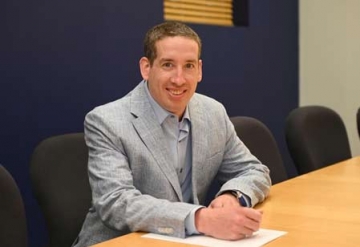THANK YOU FOR SUBSCRIBING

 Joel Victoria, Senior Construction Manager, Colliers
Joel Victoria, Senior Construction Manager, Colliers Joel Victoria is a Senior Construction Manager at Colliers, known for turning project challenges into opportunities. With a sharp eye for detail and a heart for mentoring, he leads teams through cost overruns, scheduling delays, and design changes—always finding a better way forward.
Victoria embraces tech like AI and drones for efficiency, but still champions face-to-face collaboration where it counts. A natural leader and problem-solver, he blends professionalism with a people-first approach, fostering teamwork, tenant engagement, and a fun, respectful work environment that delivers WOW-level service.
Building Success from the Ground Up
This journey has been deeply personal and, at times, very challenging.
To give you a clear overview, I started from the ground up. My career began as a cleaner—something that might not be reflected on my LinkedIn profile. From there, I moved into building maintenance, which sparked a deeper interest in how buildings are constructed.
That operational background led me to roles such as building operator, operations supervisor, and positions on the technical services side. Each role gave me hands-on experience and a deeper understanding of buildings' functions. This foundation gave me a distinct advantage as I transitioned into construction project management.
Knowing how to maintain a building provided me with practical insight into how one should be built. I’ve used that knowledge to inform my decisions in construction, blending operational and project perspectives. This mix of experience continues to shape my approach to project management today.
My Role as a Senior Construction Manager
As a Senior Construction Manager, I oversee both project execution and team leadership. I manage a team of five project managers while also handling my projects, which range from 1,000-square-foot tenant buildouts to large-scale initiatives, such as 15,000 square feet of asphalt replacement or the installation of a 20-ton commercial chiller. My work spans various building components, from rooftop units to complete tenant fit-outs.
Project sizes typically range from 1,500 to 35,000 square feet, often covering multi-tenant floors. I lead the process end-to-end—engaging consultants (architects, designers, mechanical, electrical, structural, AODA, and code specialists), procuring construction services, and managing contractors to turn plans into functional spaces.
“I manage a team of five project managers while also handling my projects, which range from 1,000-square-foot tenant buildouts to large-scale initiatives such as 15,000 square feet of asphalt replacement or the installation of a 20-ton commercial chiller”
In my leadership role, I act as both advisor and mentor, guiding project managers through constraints, risks, and key decisions. My team is highly experienced, and our collaboration is rooted in trust and accountability.
The greater challenge often lies in managing the broader project ecosystem—consultants, general contractors, subcontractors, stakeholders, and senior leadership. Each property is unique, and every project presents a new set of complexities. I also oversee quarterly forecasting, track project costs and overruns, and present detailed reports to senior leadership, providing clear visibility into project performance throughout the fiscal year.
Tackling the Challenges I Face in Every Project
Let’s break down some of the challenges I frequently encounter. First, cost overruns—an issue that has been a constant throughout my career. Poor budgeting, unexpected site conditions, material price fluctuations, and design changes are the usual suspects. Managing these is never easy, but it's our responsibility to ensure budgets and timelines are met.
Delays and schedule overruns are another ongoing challenge. Weather-dependent projects, labor shortages, and late material deliveries—especially with overseas shipments— add complexity. Tariffs only worsen the situation. As a senior, I coach my team on staying on top of scheduling and project management to minimize delays.
The labor shortage is another critical concern. Our industry is struggling to attract younger workers, and the aging workforce is rapidly shrinking, making skilled labor harder to find.
Lastly, poor communication often creates problems. Information is usually provided in bits and pieces, which can confuse. It’s essential to address this from the start, ensuring we understand who the key stakeholders are.
These challenges—cost overruns, delays, labor shortages, and communication issues—are persistent. Despite my experience, it's rare for a project to be free of them. But overcoming these obstacles is part of the job.
Guiding the Next Generation through Real Experience
If it were up to me, once I reach a certain point in my career, I’d love to transition into consulting—specifically within project management. My goal would be to share practical insights and tools with new project managers, starting with one often overlooked: lessons learned.
Too often, the focus is solely on the theory of project management. But there’s real value in sharing personal experiences—challenges I’ve faced and how we resolved them. I’ve mentored three individuals from the next generation, and when I walk them through situations I’ve encountered, they immediately relate. They’re not just learning the theory—they’re absorbing real-world lessons and applying them.
So, how do we support emerging talent? Those of us with field experience—seasoned professionals— need to step up. We must be open, communicative, and intentional about sharing what we’ve learned. Education is essential, no doubt. But mentoring and structured knowledge-sharing within organizations are just as critical.
I believe in this approach—and I’m already putting it into practice. The best part? It’s making a difference.
Balancing Technology and Human Connection in Construction
In my view, technology—especially AI— offers more advantages than drawbacks in the construction field. New tools are making us more efficient than ever. From AI-powered visual monitoring to drones surveying job sites, we can now assess progress in real time without needing to be physically present. That’s a major win for project management.
However, one drawback I’ve observed is the decline in human interaction. For instance, while Zoom or Teams calls are useful for routine updates, they can’t replace the effectiveness of in-person meetings, especially when issues need to be identified, approvals secured, or escalations addressed. On-site, faceto-face discussions tend to be far more productive and impactful, and I feel technology is limiting that vital collaboration.
That said, tools like AI cameras and drone footage have significantly enhanced how we monitor job sites. They allow us to stay updated instantly and ensure that productivity stays on track. It’s a powerful advantage, as long as we remember to keep the human element where it matters most.
Read Also
Development of the Logistics Warehousing Market in Brazil
Driving Innovation and Preserving Tradition
Operational Leadership VS Field Leadership in the Utility Construction Business
People-First Innovation: Developing Virtual Design and Construction (VDC) Training Programs to Empower Field Team Members
Sustainable Projects: Aligning Business and Purpose in Latin America
Engage Smarter: Why Constraints Matter More Than Hazards

 Copyright © 2025 All Rights Reserved | by:
Copyright © 2025 All Rights Reserved | by: Construction Tech Review
| Subscribe | About us | Sitemap| Editorial Policy| Feedback Policy














